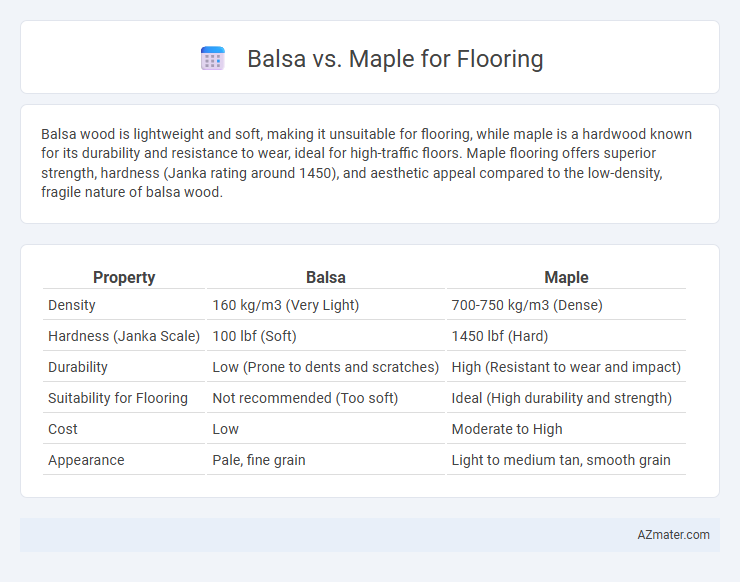Balsa wood is lightweight and soft, making it unsuitable for flooring, while maple is a hardwood known for its durability and resistance to wear, ideal for high-traffic floors. Maple flooring offers superior strength, hardness (Janka rating around 1450), and aesthetic appeal compared to the low-density, fragile nature of balsa wood.
Table of Comparison
| Property | Balsa | Maple |
|---|---|---|
| Density | 160 kg/m3 (Very Light) | 700-750 kg/m3 (Dense) |
| Hardness (Janka Scale) | 100 lbf (Soft) | 1450 lbf (Hard) |
| Durability | Low (Prone to dents and scratches) | High (Resistant to wear and impact) |
| Suitability for Flooring | Not recommended (Too soft) | Ideal (High durability and strength) |
| Cost | Low | Moderate to High |
| Appearance | Pale, fine grain | Light to medium tan, smooth grain |
Introduction to Balsa and Maple Flooring
Balsa and maple flooring offer distinct advantages based on their wood properties and usage contexts. Balsa wood, known for its lightweight and softness, provides excellent insulation and is easier to cut but may lack durability in high-traffic areas. Maple flooring, prized for its hardness and fine grain, ensures exceptional durability and a smooth finish, making it ideal for residential and commercial spaces that demand longevity.
Key Differences Between Balsa and Maple Wood
Balsa wood is significantly lighter and softer, making it ideal for lightweight applications but less durable for flooring compared to the dense, hard, and wear-resistant maple wood. Maple wood features a fine, uniform grain that offers greater strength, scratches resistance, and longevity, while balsa's coarse grain and low Janka hardness make it prone to dents and damage. The moisture resistance of maple is superior, providing better stability and less warping in flooring environments than the hygroscopic and less stable balsa wood.
Durability and Hardness Comparison
Maple flooring offers significantly higher hardness and durability compared to balsa, with a Janka hardness rating of approximately 1,450 lbf, making it resistant to dents and wear in high-traffic areas. Balsa wood, known for its extremely low density and softness, has a Janka hardness rating around 100-200 lbf, which limits its practical use for flooring due to susceptibility to scratches and damage. Choosing maple ensures long-lasting performance and structural integrity, while balsa suits applications prioritizing lightweight characteristics over durability.
Appearance and Aesthetic Qualities
Balsa wood features a pale, creamy color with a fine, uniform grain that creates a smooth and subtle aesthetic for flooring, ideal for light, airy interior designs. Maple offers a more varied palette ranging from creamy white to reddish-brown with fine, consistent grain patterns that provide a classic, elegant look and excellent durability. Both woods can be finished to enhance natural beauty, but maple's harder surface and richer grain tend to create a more refined and visually striking floor compared to balsa's softer, muted appearance.
Installation Process: Balsa vs Maple
Balsa flooring is lightweight and easier to cut, making the installation process faster and less labor-intensive compared to maple, which is denser and requires more precise tools and handling. Maple's hardness provides durability but can extend installation time due to the need for accurate fitting and potential pre-drilling for fasteners. Choosing balsa can reduce installation complexity, while maple offers greater longevity and strength post-installation.
Maintenance and Longevity
Balsa wood flooring requires less frequent maintenance due to its softness and natural resistance to wear, but it is prone to dents and scratches, impacting its longevity in high-traffic areas. Maple flooring offers superior durability and hardness, making it more resistant to wear and damage over time, which enhances its lifespan in both residential and commercial settings. Regular refinishing of maple floors can extend their longevity significantly, while balsa may need more frequent repair or replacement in demanding environments.
Cost Analysis: Balsa vs Maple Flooring
Balsa flooring costs significantly less than maple due to the fast growth rate and abundance of balsa trees, making it a budget-friendly option for large projects. Maple flooring, known for its durability and density, commands a higher price per square foot, reflecting its premium quality and longevity. When comparing long-term investment, maple's resistance to wear and tear may reduce maintenance expenses despite its higher upfront cost.
Environmental Impact and Sustainability
Balsa wood, known for its rapid growth and lightweight properties, offers a renewable flooring option with a lower carbon footprint compared to slower-growing hardwoods like maple. Maple, while durable, requires longer maturation periods and often involves more intensive logging practices, which can contribute to deforestation and habitat loss. Choosing balsa flooring supports sustainable forestry practices by promoting faster harvest cycles and reduced environmental degradation.
Best Use Cases for Each Wood Type
Balsa wood, known for its exceptional lightness and softness, is best suited for decorative flooring in low-traffic areas or artistic applications where lightweight properties are essential. Maple wood, characterized by its hardness, durability, and fine grain, excels in high-traffic residential and commercial flooring, offering long-lasting wear resistance and a smooth, polished finish. Choosing between balsa and maple depends on the balance between aesthetic needs and functional demands, with maple favored for practical flooring solutions and balsa ideal for specialized, low-impact designs.
Conclusion: Which Flooring is Right for You?
Maple flooring offers superior hardness and durability, making it ideal for high-traffic areas and long-term use, while balsa provides a lightweight, softer option suited for low-impact spaces or decorative flooring. Choosing between balsa and maple depends on your priorities: durability and longevity favor maple, whereas ease of cutting and installation or cushioning prefers balsa. Consider factors like foot traffic, maintenance, and aesthetic preferences to determine the flooring that best meets your functional and design needs.

Infographic: Balsa vs Maple for Flooring
 azmater.com
azmater.com